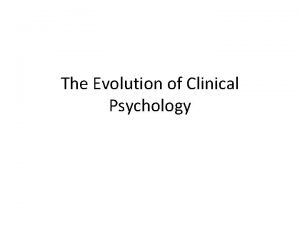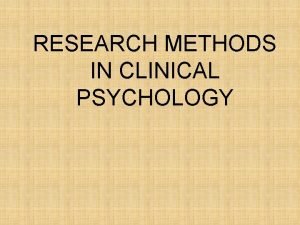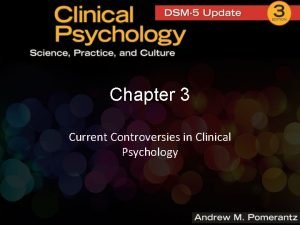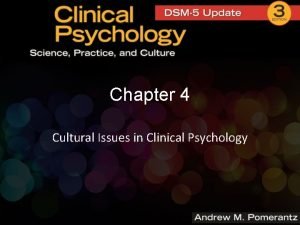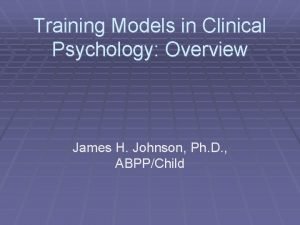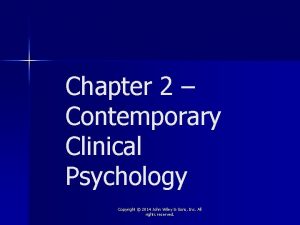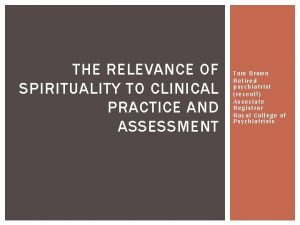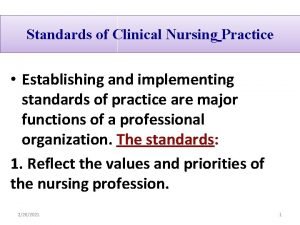1 INTRODUCTION TO CLINICAL PSYCHOLOGY SCIENCE PRACTICE AND

















- Slides: 17

1 INTRODUCTION TO CLINICAL PSYCHOLOGY: SCIENCE, PRACTICE AND ETHICS CLASSİFİCATİON & DİAGNOSİS Assist. Prof. Merve Topcu Department of Psychology, Çankaya University 2016 -2017, Fall

2

3 Classification • Validity • The extent to which the principles used in classifying an object are effective in capturing the nature of reality • Utility • The usefulness of the resulting classification scheme • Categorical approach • Dimensional approach • Diagnostic system • A classification based on rules used to organize & understand disease & disorders • Yield diagnosis & describe individuals’ condition • Stigmatization • Potential for an inaccurate diagnosis

4 Q What is normal?

5 What is abnormal? • Rare, unusual, or bizarre behavior is not always abnormal • Context is very important • Age • Cultural heritage • Gender Role Expectations • Diagnosis for children vs adults • Developmental psychopathology • Examines problem behavior in relation to milestones specific to each stage of developement • Milestones based on emprical evidence • Interested in course of the problem E. g. , In many cultures, family members sleep together in one room, often in the same bed. In the U. S. , it is considered normal for a baby to sleep in her own bed in her own room.

6 Diagnostic criteria • Diagnosis based on diagnıstic criteria • Cirteria include cluster of symptoms that go together • Rely on literature findings

7 Definition of “Mental Disorder” DSM-IV-TR: ‘. . . a clinically significant behavioral or psychological syndrome or pattern that occurs in an individual and that is associated with present distress (e. g. , a painful symptom) or disability (i. e. , impairment in one or more important areas of functioning) or with a significantly increased risk of suffering death, pain, disability, or an important loss of freedom. In addition, this syndrome or pattern must not be merely an expectable and culturally sanctioned response to a particular event, for example, and death of a loved one. Whatever its original cause, it must currently be considered a manifestation of a behavioral, psychological, or biological dysfunction of the individual. Neither deviant behavior (e. g. , political, religious, or sexual) nor conflicts that are primarily between the individual and society are mental disorders unless the deviance or conflict is a symptom of a dysfunction in the individual, as described above. ’ (APA, 2000 p. xxxi)

8 Definition of “Mental Disorder” • Harmful dysfuntion / impairment • Dyscontrol • Prevalence of mental disorders • Still unipolar depressive disorder leading cause • Substance use, Alzeimer’s • Biopsychosocial model in understanding mental disorders

9 Historical overview of psychiatric classification • The science of classifying abnormal patterns of behavior and experience is called nosology • The root of nosology can be traced back to Hippocrates, who established a classification scheme that remained influential throughout ancient Greece and Rome • Diagnostic categories included mania, melancholia and hysteria

10 DSM-I • DSM, in 1952 • Relying mostly on psychoanalytic etiology • The first official manual of mental disorders to contain a glossary of descriptions of the diagnostic categories • Used the term “reaction, ” reflecting Adolph Meyer’s psychobiological view that mental disorders represented reactions of the personality to psychological, social and biological factors • Multiaxial diagnostic system

11 Multiaxial diagnostic system

12 DSM-II • ICD-6 (1948) had been the first ICD to include a subdivision on mental disorders, but had only been adopted by 6 countries by 1959. • Stengel (1959) found many diagnostic systems in use around the world. • This led to the need for a consensual system for all WHO countries, which was to be included in the ICD-8. • The resulting system was adopted, with minor revisions, and published as DSM-II in 1968.

13 DSM-II (cont. ) • Like DSM-I, each disorder represented a categorical entity, with diagnosis based on a brief general description • E. g. , Anxiety Neurosis • This neurosis is characterized by anxious over-concern extending to panic and frequently associated with somatic symptoms. Unlike phobic neurosis, anxiety may occur under any circumstances and is not restricted to specific situations or objects. This disorder must be distinguished from normal apprehension or fear, which occurs in realistically dangerous situations. • The main problem with DSM-II was the lack of an objective and reliable system for describing psychopathology and determining diagnoses • 1970’s, operational criteria for making diagnostic decisions

14 DSM-III • In 1974, the APA appointed the Task Force on Nomenclature and Statistics to begin work on DSM-III • Emphasis was placed on increasing reliability and clinical utility • Represents a “dramatic departure” from previous DSM’s • What is new? • Provided a definition of the term “mental disorder” • Presented diagnostic criteria for each disorder • Introduced the multiaxial diagnostic format • Redefined a number of major disorders (e. g. , elimination of “neurosis”) • Added new diagnostic categories (e. g. , personality disorders) • Presented a hierarchical organization of diagnostic categories • Presented a systematic description of each disorder • Provided decision trees for differential diagnosis • Provided a glossary of technical terms • Published reliability data from field trials • Utilized a descriptive, a theoretical approach

15 DSM-III-R, DSM IV & DSM V • DSM-III-R in 1987 • changes, including a revision of the multiaxial system (especially Axis II, which was broadened to include mental retardation, and Axis V, which introduced a more comprehensive rating scale) • DSM IV-R • By the American Psychiatric Association • Primarily used in the United States • Classifies mental illnesses into different types of disorders (Mood disorders, psychotic disorders, eating disorders, etc. ) • Subtypes and/or Specifiers

16 DSM-III-R, DSM IV & DSM V (cont’d) • DSM IV-R (cont’d) • Recording Procedures • Associated Features and Disorders • • • Associated descriptive features and mental disorders Associated laboratory findings Associated physical examination findings and general medical conditions • Specific Culture, Age and Gender Features • Prevalence • Course • Familial Pattern • Differential Diagnosis • Comorbidity

17 Fin. .
 Scope of clinical psychology
Scope of clinical psychology Clinical psychology science practice
Clinical psychology science practice Wwwk-6.thinkcentral
Wwwk-6.thinkcentral Nature of clinical psychology
Nature of clinical psychology Science is my favourite subject
Science is my favourite subject Research design in clinical psychology
Research design in clinical psychology Current controversies in clinical psychology
Current controversies in clinical psychology Penn state clinical psychology
Penn state clinical psychology Clinical psychology definition
Clinical psychology definition Cultural issues in clinical psychology
Cultural issues in clinical psychology Models of clinical psychology
Models of clinical psychology Masters in clinical psychology uae
Masters in clinical psychology uae Introspection method of psychology
Introspection method of psychology Doctorate in clinical psychology clearing house
Doctorate in clinical psychology clearing house Contemporary clinical psychology
Contemporary clinical psychology Transforming teacher education through clinical practice
Transforming teacher education through clinical practice Spirituality in clinical practice
Spirituality in clinical practice Standards of clinical nursing practice
Standards of clinical nursing practice



